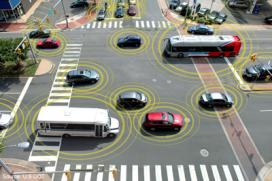Connected Vehicle Policy Analysis
Connected vehicle policy analysis supports research and analysis into critical policy and institutional issues that may influence or determine the successful deployment of vehicle-to-vehicle (V2V) and vehicle-to-infrastructure (V2I) technologies.
Volpe’s research supports the development and comparison of effective policy options, resulting in reasoned alternatives for policy makers and decision makers. Connected vehicle policy research is a collaborative effort between the DOT, key industry stakeholders, vehicle manufacturers, state and local governments, representative associations, citizens, and others.
The Challenge
A successful and sustainable deployment of connected vehicle technologies requires that policy and institutional issues be identified and addressed, and that policy alternatives be considered and evaluated.
The Solution
Volpe’s work in connected vehicle policy analysis addresses the following issues:
- Governance, finance, and operating models
- Institutional security, trust credentials, and resiliency
- Certification
- Telecommunications
- Intellectual property
- Interoperability
- Data governance and data ownership
- Privacy
- Liability
- Social equity
Volpe’s capabilities include the following:
- Issues identification based on technology architecture and technology platform reviews
- Options analysis/comparative analysis
- Assessment of new policies and analysis of how existing policies support new technologies
- International harmonization to support a global marketplace
- Market, stakeholder, and public acceptance analysis
- Institutional issues analysis and institutional modeling
- Deployment and operations funding/financing strategies
Impacts
Volpe’s analysis of connected vehicle policy accomplishes the following:
- Establishes a policy foundation that supports feasible and practicable market adoption and the use, implementation, operations, and maintenance of new technologies as they are mainstreamed into use
- Assures, early on, that public acceptance issues—safety, privacy, liability, ownership, cyber-risk, social equity, and others—are factored into policy development and decision making
- Identifies and clarifies the role of the U.S. DOT based on authority, risk, and public benefit
- Provides stakeholders, Congress, and the public with an objective, fact-and evidence-based analysis on the options in support of the resulting conclusions, policy positions, and Departmental role
Customers

Intelligent Transportation Systems Joint Program Office (ITS JPO)
Federal Highway Administration (FHWA)
Federal Transit Administration (FTA)
National Highway Traffic Safety Administration (NHTSA)
